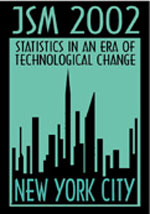|
Activity Number:
|
163
|
|
Type:
|
Invited
|
|
Date/Time:
|
Tuesday, August 13, 2002 : 8:30 AM to 10:20 AM
|
|
Sponsor:
|
Section on Survey Research Methods*
|
| Abstract - #300286 |
|
Title:
|
Two-Sequence Latent Transition Models
|
|
Author(s):
|
Linda Collins*+ and Brian Flaherty and Zhiqun Tang
|
|
Affiliation(s):
|
Pennsylvania State University and Pennsylvania State University and Pennsylvania State University
|
|
Address:
|
S-159 Henderson Bldg., University Park, Pennsylvania, 16802,
|
|
Keywords:
|
|
|
Abstract:
|
Latent Transition Analysis (LTA) is an extension of latent class models to longitudinal data. In LTA, models are fit involving stage-sequential movement among latent classes over time. The prevalence of latent classes, the incidence of transitions among latent classes, and probabilities of responses conditional on latent class membership at each time are estimated. In this talk we discuss a variation on latent class/LTA models that allows the examination of relationships between two stage sequences. This two-sequence model identifies an X sequence and a Y sequence. Quantities such as latent class prevalence and conditional response probabilities are featured in this model in much the same way as in ordinary latent class/LTA models. New parameters include the probability of latent class membership in the Y sequence conditional on latent class membership in the X sequence, and the incidence of transitions among the Y sequence latent classes conditional on transitions among the X sequence latent classes.
|

